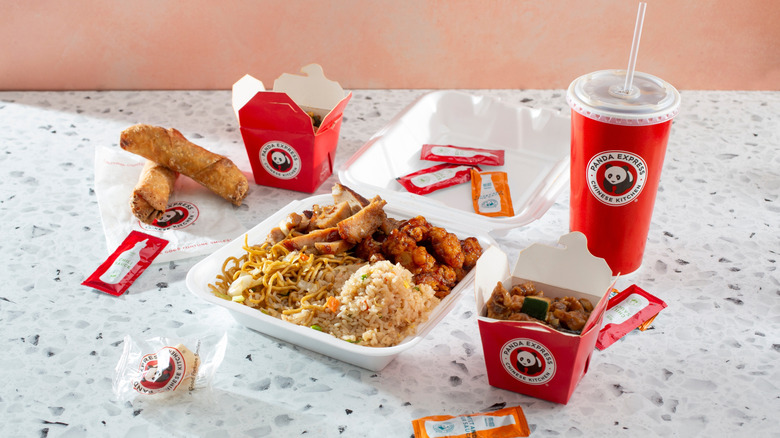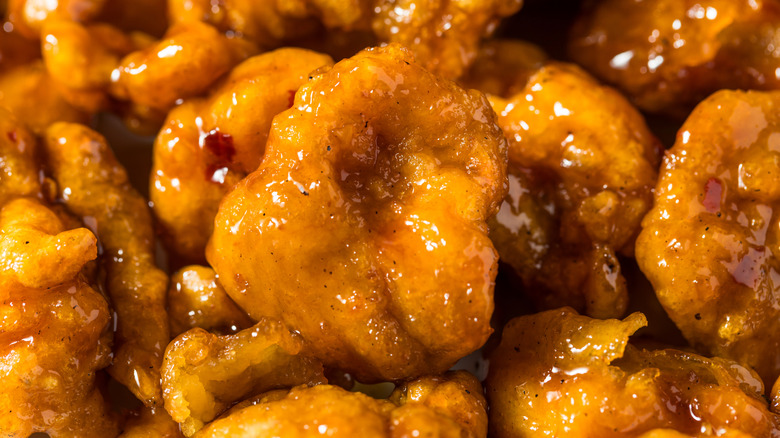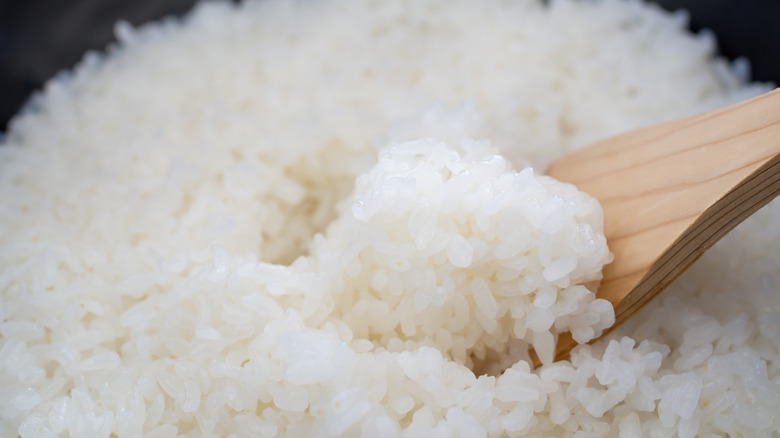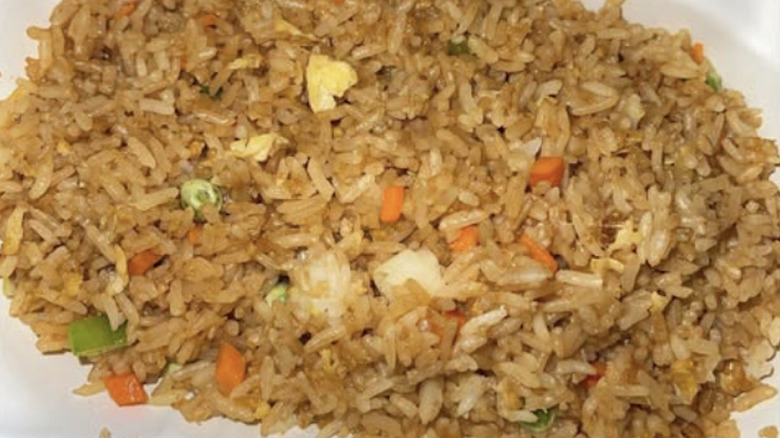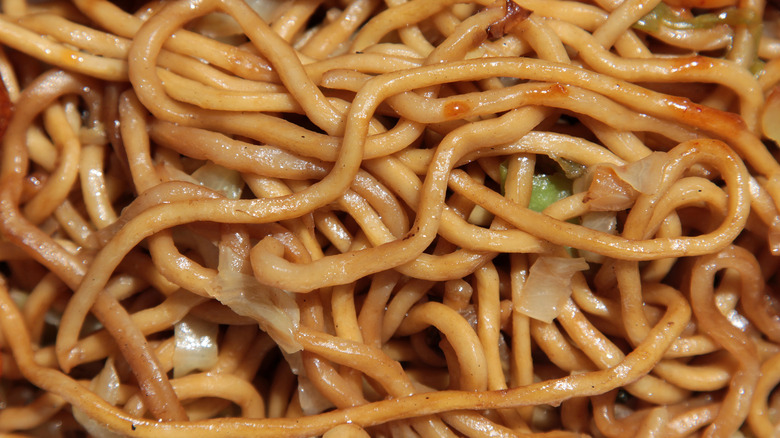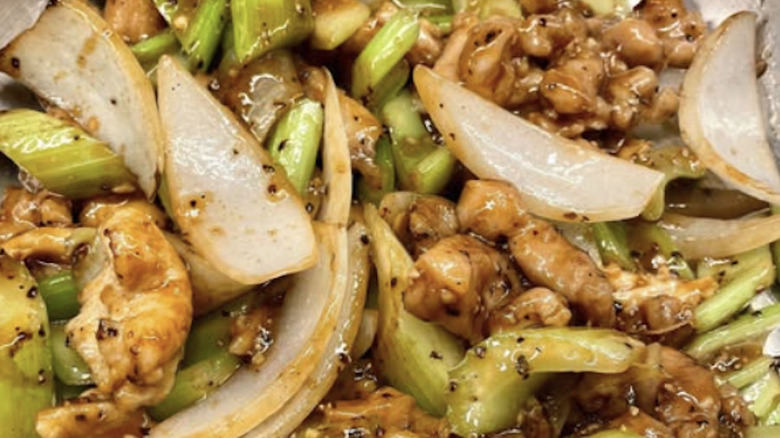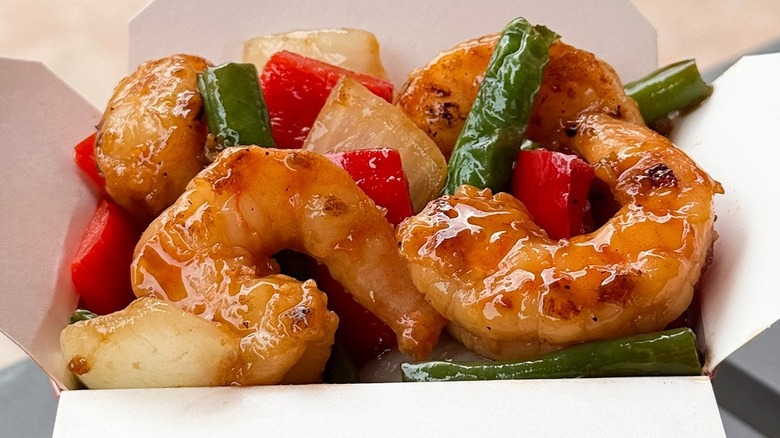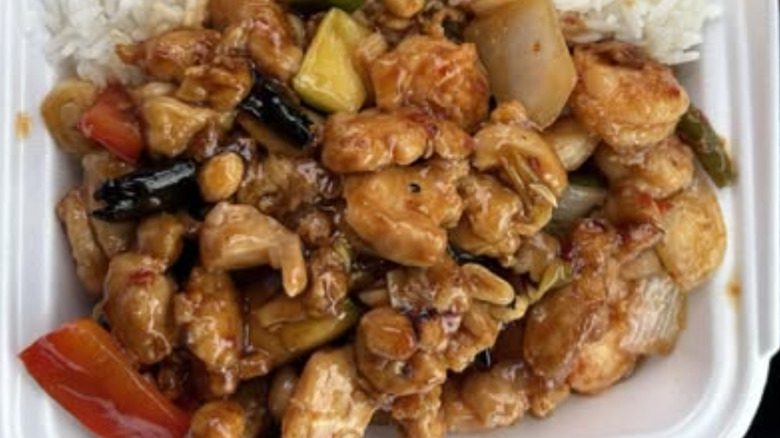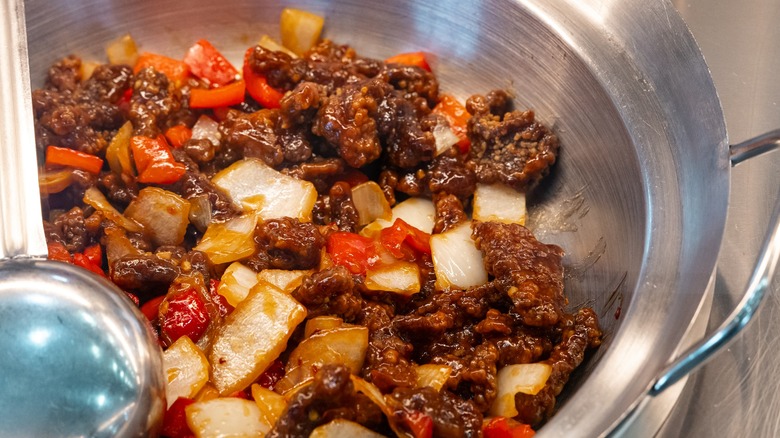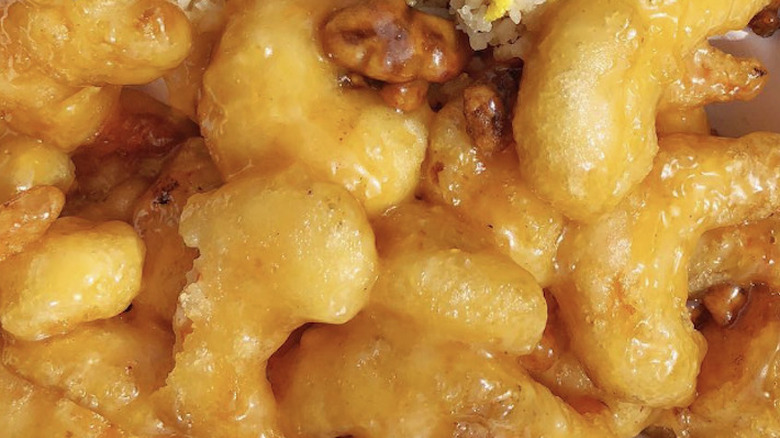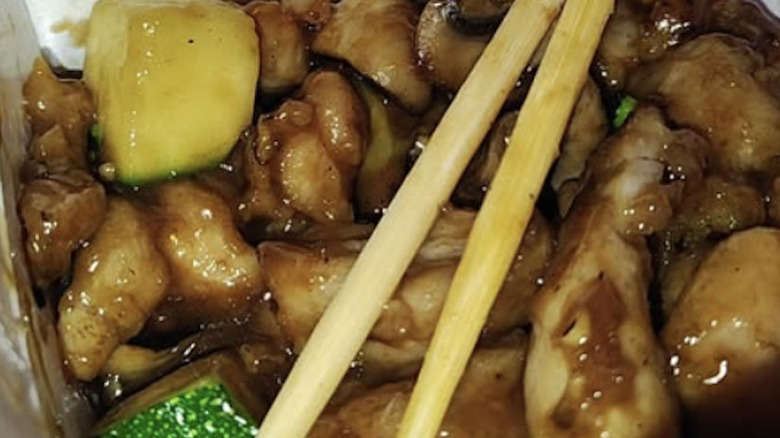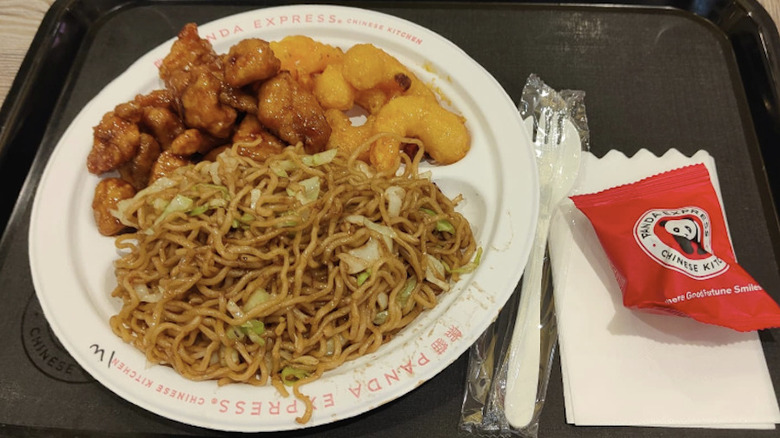11 Unhealthiest Items On The Panda Express Menu
First launched as a spinoff of the more upscale Panda Inn, Panda Express is now a fast food empire that not only offers delicious Chinese-inspired dishes but is also considered one of the best fast food chains to work at. Over the course of just four decades, it has established itself as the leading Chinese-American chain in a crowded and competitive industry, nailing hot, fresh, saucy, spicy, sweet, sour, and savory dishes alike. Many of Panda Express's dishes compare favorably to those from traditional takeout spots, because its chefs know exactly how to lure customers and keep them coming back regularly.
How does Panda Express do it? The reality is that healthy eating or conscientious cooking probably isn't the number one priority for Panda Express when devising or executing its recipes. Most of its menu — and certainly its most frequently ordered entrees and sides — is packed with surprisingly high amounts of calories, fat, sodium, and sugar. Even though the food is relatively simple, and vegetables are more plentiful in its dishes than at most other fast food places, most of the offerings at Panda Express are categorically not healthy. Here are the 13 most nutritionally vacant items you can order at Panda Express.
Orange chicken
The entire Panda Express chain arguably owes its life to its signature and most popular dish, orange chicken, created in 1987. Panda Express's orange chicken remains the pinnacle of junky Chinese-American takeout, putting a citrus-heavy spin on the staple of General Tso's chicken. It starts with small pieces of chopped chicken, which are heavily breaded, pan-fried, and then coated in a thick, gloopy sauce that's savory, spicy, and very sweet. All those ingredients add a significant amount of calories and more to the otherwise healthy chicken breast.
When ordered as an individual entree choice on one of Panda Express's combination plates, the portion of orange chicken served weighs slightly less than 6 ounces, and yet it packs 510 calories. Of that amount, 220 calories come from the 24 grams of fat. Saturated fat makes up 5 grams of that amount. The 850 milligrams of sodium also feel disproportionately high, while the breading and sauce add a lot of carbohydrates. You'll find 53 grams of carbs in each serving of orange chicken, of which 20 grams come purely from sugar.
White steamed rice
Panda Express unsurprisingly sells an abundance of standardized Chinese-American takeout — the kind of cuisine that was increasingly served at independent and family-run establishments for the second half of the 20th century. Generous portions of a staple carbohydrate typically accompany entrees at Chinese-American eateries, and the combo bowls and meals at Panda Express always include the customer's choice of rice, chow mein, or mixed greens. None of the side options (besides the vegetables) are particularly healthy, adding an abundance of calories, fat, and sugar to diners' diets without providing much nutritional value.
That's even true of the simple, humble white steamed rice. Panda Express's mass-cooked rice is prepared in large steaming units without the addition of any fat, but it's still nutritionally empty and calorically dense. An 11-ounce helping of white steamed rice at Panda Express packs 520 calories with a whopping 118 grams of carbohydrates. There's no fiber there to slow its absorption, and as far as blood glucose is concerned, the body treats that rice like it's a massive influx of sugar.
Fried rice
One of the most widely consumed foods on the planet, rice is generally inexpensive, tasty, and full of the vital calories needed to sustain life. But when it's introduced into an American fast food situation, where the calories are already plentiful, it can be too much of a good thing. And when ordinary white rice is transformed into fried rice, that only makes for more saturated fat, more sodium, and even more carbohydrates.
White rice cooked in fat with some finely chopped vegetables in the mix becomes fried rice. That's pretty much a meal unto itself, but at the rather decadent eatery that is Panda Express, it's merely a side dish. A heaping pile of the stuff is typically served on a plate or in a paper box next to some heavily sauced chicken or beef. Even when served in a portion meant to act as a costar to the main entree, the vegetable fried rice at Panda Express has a similar nutritional profile to a full-blown meal, and then some.
Panda Express's take on the classic takeout dish is an 11-ounce serving, which contains 620 calories, 19 grams of fat (4 grams of which are saturated fat), 1,000 milligrams of sodium, and just over 100 grams of carbohydrates. That's just under half of our daily recommended sodium limit. And that's from just one side dish.
Chow mein
Food courts have saved dying malls, and we think it's at least partially thanks to staples like giant plates of chow mein. Available in various versions at most any Chinese-inspired restaurant, quick-serve food stands, and like-minded rivals to Panda Express, chow mein is pure comfort food: long, moderately thick noodles cooked soft and then tossed in a pan full of oil and just a few finely chopped vegetables until everything is golden brown and drenched in fat.
At Panda Express, meat-free chow mein is available on its own or as a side dish for combo meals. Many customers opt for steamed white rice or fried rice, but Chinese takeout aficionados know that the glutinous, velvety, and filling noodles that make up the bulk of an 11-ounce order of chow mein promise true culinary pleasure.
Unfortunately, Panda Express's chow mein contains not just satisfaction but also a thunderous level of nutritional macros, making it an unhealthier alternative to the already not-so-great rice choices. The way Panda Express makes it, the chow mein winds up containing 600 calories — a significant portion of an adult's daily need — of which 210 calories are derived from the 23 grams of fat. The chow mein also boasts 4 grams of saturated fat, 1,000 milligrams of sodium (more than 40% of the recommended daily intake), and 94 grams of carbohydrates.
Black pepper chicken
Panda Express patrons looking to make healthier choices when they dine at the fast food restaurant can — and do — look for a round green pan icon on the menu. That symbol indicates that the item is one of Panda Express's Wok Smart-certified entrees, which, under standard preparation, are low on calories and high on protein: no more than 300 of the former, and no less than 8 grams of the latter. However, the Wok Smart stamp can be deceiving, because while a menu item may qualify on the calorie and protein front if its totals fit those somewhat arbitrary benchmarks, it may also include wildly unhealthy levels of fat, cholesterol, or sodium.
The black pepper chicken at Panda Express is a prime example. At first glance, it may seem relatively innocuous. Each serving has just 280 calories and a respectable 13 grams of protein, with a standard Chinese-American combo of chopped celery and onions along with white meat chicken pieces in a light, peppery sauce. It's in this sauce where most of the unhealthy stuff lives. The dish has 19 grams of fat (with 3.5 grams of saturated fat) and 1,130 milligrams of sodium — almost half of the USDA's one-day limit.
Wok-fired shrimp
As another Panda Express entree choice that earns the special Wok Smart label for its presumed healthiness, the wok-fired shrimp is one of the least caloric entrees on the entire menu at the Chinese-American fast food chain. Deriving most of its flavors from a simple sauce, multiple sources of heat, and vegetables, the wok-fired shrimp comes together by searing shrimp and vegetables like onions, red and yellow bell peppers, and sugar snap peas (which are distinctively different from snow peas) and then lightly coating it in a sauce with chilis, chipotle peppers, and jalapeño peppers.
It would seem that the ingredients that pull all those disparate factors into one cohesive dish are salt and sugar. While the 6-ounce, entree-size portion of wok-fired shrimp contains only 190 calories, 5 grams of fat, and a formidable 17 grams of protein, it also sneaks in 1,140 milligrams of sodium and 15 grams of sugar. That's almost half of the USDA's recommended daily salt intake limit. While Panda Express doesn't break down the sugar content by natural and added sugars, it's safe to assume that this 15 grams also contains a decent chunk of your added sugar allowance.
Kung pao chicken
Another Chinese-American standard item that has earned a forever spot on the Panda Express national menu is kung pao chicken. The chain's take on the classic dish is fairly typical, consisting of small chunks of soft chicken and various crispy vegetables, including onions and celery, as well as red-hot chilis and a smattering of peanuts enrobed in a thick, sometimes-spicy sauce.
On a superficial level, the kung pao chicken seems somewhat healthy, as it's heavy on veggies. It also has a relatively light final count of 320 calories with a robust 17 grams of protein and 15 grams of carbohydrates. But for what it is, the nearly-7-ounce portion of kung pao chicken is surprisingly high in salt. The 1,050 milligrams of sodium makes it one of the saltiest entrees on the entire Panda Express menu, as well as consuming a sizeable chunk of your daily recommended intake, even before you take into account any possible sides.
Beijing beef
Beijing beef is one of Panda Express's signature offerings. A mix of tastes and textures, it combines thin slices of beef that have been lightly battered and fried in oil until they're crisp with a spicy sauce that seeps into the meat, onions, and red bell peppers.
By its very nature, beef is well stocked with calories and fat. When it's coated, fried, and covered in sauce, that adds a lot more calories and fat, as well as sodium. A serving of Panda Express's Beijing beef weighs only about 6 ounces, but it provides 480 calories. Over half of this caloric total is contributed by the 27 grams of fat in the dish.
While there's a good level of protein — 14 grams, to be precise — in Beijing beef, the dish also contains even more sugar, with 21 grams in total. While not quite as eye-watering as the contents of some other dishes, the 600 milligrams of sodium also represents more than a quarter of what one should safely eat over a whole day.
Honey walnut shrimp
Foisting orange chicken upon the world has worked out very well for Panda Express, so much so that it has attempted to recreate the winning concept with other proteins to make exciting new Chinese-inspired menu items. A premium option at Panda Express is the honey walnut shrimp, which is essentially the seafood version of the orange chicken. Whole, small shrimp are battered and cooked until they're crispy, brown, and fluffy, and then they're covered in a very sweet sauce, complemented by little bits of crunchy walnuts.
Much like the orange chicken, the honey walnut shrimp isn't the most nutritionally sound option at Panda Express. All that battering, frying, and sugary saucing sends the calories, fat, and sugar numbers skyward. A 4-ounce portion of the item adds 430 calories to a diner's diet, as well as 28 grams of fat. The 700 milligrams of sodium, just under 30% of the one-day maximum, also isn't ideal. There is, however, surprisingly less sugar in the honey walnut shrimp than in the honey sesame chicken breast, at 9 grams per serving.
Mushroom chicken
There doesn't seem to be a whole lot going on with the mushroom chicken at Panda Express. It consists of little more than bite-sized pieces of unbreaded chicken, thick slices of zucchini, and large mushroom pieces. It's all tossed in a light but flavorful and savory sauce, and that seems to be where the negatively impactful elements factor into the dish's nutritional makeup.
The mushroom chicken is another one of the Panda Express Wok Smart menu items that squeezes into the category because of its limited calorie count and high protein figure (a scant 220 calories and a moderate 13 grams of protein), while scoring too-high numbers in other categories. The not-quite-6-ounce entree portion of mushroom chicken ends up with 14 grams of fat, of which 2.5 grams is the more concerning saturated variety. It also contains 840 milligrams of sodium, or more than 35% of what the USDA thinks an individual ought to consume in a day, at the very most. That's a lot of extra fat and salt for a dish that's outwardly a healthy combination of white-meat chicken and two kinds of vegetables.
Orange chicken Cub Meal
Children have different nutritional needs, depending on their ages, so the USDA doesn't have uniform dietary guidelines for all juveniles. It does, however, recommend that kids generally consume less than adults. As such, an ideally healthy fast food kids' meal should have nutritional content proportional to a child's daily intake. Panda Express offers three fixed, plated options for younger customers: Cub Meals. The meals built around entrees of broccoli beef and grilled teriyaki chicken are relatively healthy, topping out at 300 calories and 7 grams of fat, and 400 calories and 16 grams of fat, respectively.
The one Cub Meal that doesn't stack up quite as well is the orange chicken option. Panda Express makes it with smaller portions of orange chicken and white rice, but the meal still holds 580 calories, 17 grams of fat, 705 milligrams of sodium, and 84 grams of carbohydrates. To its credit, the chain tries to make the meal healthier with the inclusion of cooked green vegetables, apple crisps, and a bottle of water (as opposed to a sugary soda), but that all couldn't overtake the salty, caloric wallop of the orange chicken and rice.
Methodology
To determine what's considered unhealthy at Panda Express, we examined the chain's extensive national menu of entrees, sides, and combination meals available in its network of stores at the time of writing and found the items with the highest figures in terms of calories, fat, saturated fat, sodium, and total carbohydrates, which includes sugar. It's worth noting that the exact portion sizes and nutritional values may differ, depending on the restaurant.
The United States Department of Agriculture publishes carefully calculated guidelines for what the average American adult should consume of those nutritional macros across a day in order to maintain relatively good health. The agency recommends limiting oneself each day to 2,000 calories, 2,300 milligrams of sodium, and 50 grams of added sugar. It also recommends limiting your intake of saturated fat to less than 10% of the total calories consumed per day. Items on the Panda Express menu were determined to be unhealthy based on how quickly or easily they approached any number of those USDA-provided limits.
